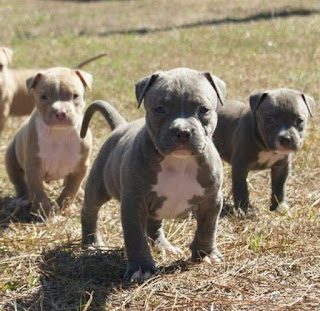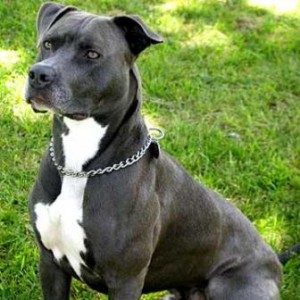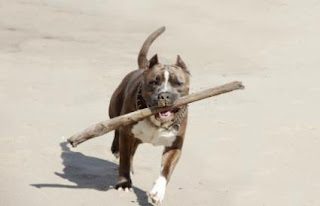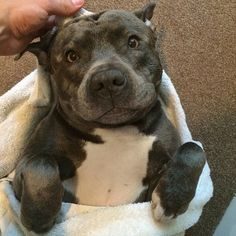Everything about your Pit Bull
The American Pit Bull Terrier has been known by many names, including the Pit Bull and the American Bull Terrier. It is often confused with the American Staffordshire Terrier, however, the United Kennel Club recognizes the American Pit Bull Terrier as its own distinct breed. Affectionately known as “Pitties,” the Pit Bull is known for being a loyal, protective, and athletic canine breed.
Overview
The American Pit Bull Terrier, also known at times as the Pit Bull, the Pit Bull Terrier, the American Bull, the American Pit Bull, the American Pit Bull Dog, the Pit Dog, the Half-and-Half, the American Bull Terrier, the Yankee Terrier, the Yankee Bull Terrier and the Staffordshire Terrier, descends from the Staffordshire Bull Terrier of England. This is a well-balanced dog whose tremendous strength is unusual for its moderate size. Pit Bulls, who are not recognized by the American Kennel Club, share a common history with the AKC-recognized American Staffordshire Terrier. Pit Bulls, like Am Staffs, are stocky, powerful yet agile, well-muscled and highly intelligent. Although descended from dogs bred for bull baiting and pit fighting, and unfortunately still used by unscrupulous owners in illegal dog fighting circles, Pit Bulls have many remarkable qualities, including their gameness, trainability, loyalty and affection.
The Staffordshire Terrier was accepted for registration in the American Kennel Club Stud Book in 1936. The name of the breed was revised in 1972 to the American Staffordshire Terrier, to distinguish it from the Staffordshire Bull Terrier of England, which is much lighter in weight. The American Pit Bull Terrier was the first breed registered with the United Kennel Club, in 1898. Pit Bulls and Am Staffs are virtually the same animal, with different club registrations. Most Pit Bulls are between 17 and 19 inches at the withers and weigh on average between 60 and 80 pounds. Their short, stiff, glossy coat can be of any color or color combination. Pit Bulls require minimal grooming; brushing with a firm-bristled brush and an occasional bath should suffice.
Highlights
- American Pit Bull Terriers are not a good choice for people who can give them little or no attention.
- They must be trained and socialized when young to overcome the breed’s tendencies toward stubbornness and bossiness, which combined with his strength can make him hard to handle if he hasn’t learned you are in charge.
- Your American Pit Bull Terrier must be kept on leash in public to prevent aggression toward other dogs. It’s not a good idea to let these dogs run loose in dog parks. While they might not start a fight, they’ll never back down from one, and they fight to the finish. American Pit Bulls who aren’t properly socialized as puppies can become aggressive toward other dogs.
- Breed-specific legislation almost always includes this breed. Be aware of rules in your area as well as neighboring regions if you travel with your dog.
- American Pit Bull Terriers have a great need to chew, and powerful jaws make quick work of cheap or flimsy toys. Give yours only tough, durable toys that can’t be chewed up and swallowed.
- American Pit Bull Terriers are best suited to owners who can offer firm, fair training, and gentle consistent discipline.
- The term “Pit Bull” is often applied indiscriminately to APBTs, American Staffordshire Terriers and sometimes Staffordshire Bull Terriers, a British breed. The term may also be used to label any dog who resembles those breeds, even if he is a Lab mix with little or no “Pit Bull” in his background.
- An APBT comes in any color, pattern or combination of colors, except merle.
- Celebrities who count Pitties as their best friends include actresses Jessica Alba, Jessica Biel and Alicia Silverstone; cooking guru Rachael Ray; and political satirist Jon Stewart.
Dog fighting was used as both a blood sport and a way to continue to test the quality of their stock. For decades afterwards, dog fighting clandestinely took place in small areas of Britain and America. In the early 20th century pit bulls were used as catch dogs in America for semi-wild cattle and hogs, to hunt, and drive livestock, and as family companions. Some have been selectively bred for their fighting prowess.
- Billie Holiday’s companion “Mister“,
- Helen Keller’s dog “Sir Thomas“,
- Buster Brown’s dog “Tige“,
- Horatio Jackson’s dog “Bud“,
- President Theodore Roosevelt’s Pit Bull terrier “Pete“,
- “Jack Brutus” who served for Company K,
- the First Connecticut Volunteer Infantry during the civil war,
- Sergeant Stubby who served for the 102nd Infantry, 26th (Yankee) Division during World War I,
- and Sir Walter Scott’s “Wasp“.
- Weela, who helped save 32 people, 29 dogs, 3 horses, and 1 cat;
- Popsicle, a five-month-old puppy originally found nearly dead in a freezer, who grew to become one of the nation’s most important police dogs;
- Norton, who was placed in the Purina Animal Hall of Fame after he rescued his owner from a severe reaction to a spider bite;
- Titan, who rescued his owner’s wife, who would have died from an aneurysm,
- D-Boy, who took three bullets to save his family from an intruder with a gun,
- Lilly, who lost a leg after being struck by a freight train while pulling her unconscious owner from the train tracks
- Daddy, Cesar Millan’s right-hand dog was famous for his mellow temperament and his ability to interact calmly with ill-mannered dogs.









